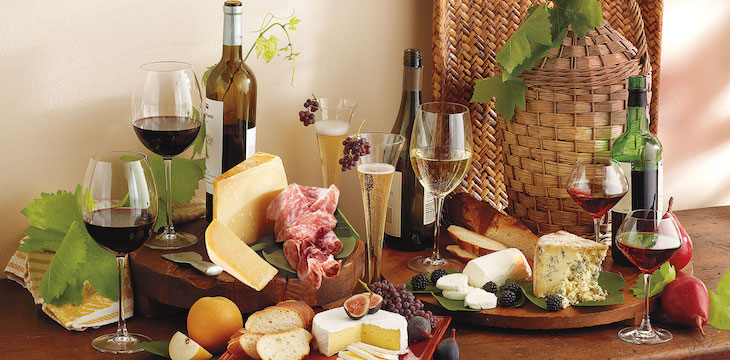
Ever since I spent over a year in Europe during my university days, I have had a love affair with cheese. The stinkier the better; just like chou tofu and Korean fermented bean paste. When I started to enjoy wine, it was confusing to me how different cheese pair with an infinite variety of wines. Over the years I have narrowed down the pairings to some simple steps, regardless of whether you are a cheese connoisseur or not.
First, I try to break down the cheese into one of five different styles: Creamy, high-fat content cheeses like brie and camembert; hard cheeses like parmigiano-reggiano and pecorino; goat cheese; soft fresh cheeses like mozzarella, burrata and ricotta; blue cheese like stilton or gorgonzola. Generally the styles dictate the wine so the pairing then becomes easier.
Creamy cheeses love medium to full bodied white wines with crisp acidity that can cut through the richness. Great pairings include Brie with Meursault or Camembert with white Hermitage and Epoisses with sweet demi-sec Vouvray.
Hard cheeses have strong salty flavors that call out for bold wines that can stand up to the flavors. Italian wines are perfect for this category depending on the intensity of the flavors. Parmigiano-reggiano pairs well with southern Italian wines like Aglianico and Nero d’Avola while Pecorino works really well with Montepulciano or a simple Chianti Classico.
Goat cheese has fresh, herbal flavors and pairs brilliantly with Pinot Gris or Chenin Blanc, or if the flavors are more delicate try Chassagne-Montrachet from Burgundy. Fresh cheeses like mozzarella and burrata work well with light, lightly citrus and minerally white wines like Friuili’s Pinot Grigio or vintage Champagne. Blue cheese are on the other end of the spectrum from fresh cheese because of their salty, powerful flavors. Best pairings for this category are bold, sweet Port or other sweet, late-harvest wines.
If you can find Bernard and Jean Francois Antony cheeses, it is worth the search. He is the purveyor of cheeses to Michelin star chefs around the world, including those in Hong Kong and China. The Antonys provide artisanal, ‘real’ cheeses to Alain Ducasse in Paris, Daniel Boulud in New York and to properties like the Four Seasons Hotel and Shangri-la Hotel in Hong Kong.
What makes Antony’s cheeses so special is that the family not only selects quality cheese but also ages them in their own cave in southern Alsace. Jean Francois Antony explains that aging cheese makes a huge difference on final taste and quality. According to Antony, the final flavor of the cheese is derived from the atmosphere of the cellar as well as the microorganisms in the environment.
Working exclusively with raw-milk types, Jean Francois Antony is very particular about selecting and buying only the best. He says, “A cheese maker is ideally just a couple, one or two people. After that it is too big. It is important that one person makes the cheese and sees it through the entire process. We believe great cheese can not be made by a large team of people.” Less than ten people work for Antony and they have no thoughts of expanding despite increasing international demand for their hand-selected and matured cheeses.
Below are some tips on buying cheese:
- The best cheese should be mature but not too runny (if it is a soft cheese)
- When cheese starts to be cut, it needs to be consumed within 2 weeks. Never keep unpasteurized cheese for more than two weeks in the fridge.
- The best season to buy cheese is in summer or early fall.
- Serve most cheeses at room temperature, around 20*C.
- Like wine, only very good cheese can be matured, which is a tiny percentage of total cheese production.









